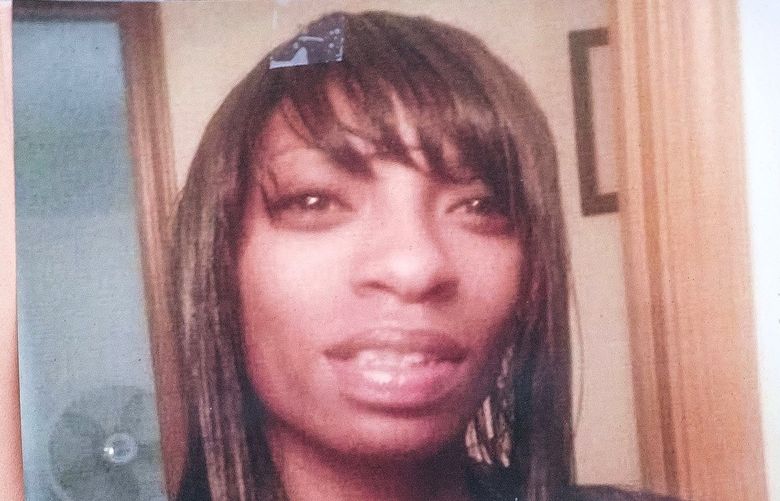One minute, Charleena Lyles was calmly talking about a missing Xbox. The next, she was lunging at Seattle police Officer Jason Anderson with a knife, coming within an inch of his belly as he jumped back and drew his handgun, he recalled in dramatic and emotional testimony Thursday afternoon.
Anderson, in his first public statements about the 2017 shooting of Lyles, a pregnant 30-year-old mother of four, said the burglary investigation he and fellow officer Steven McNew responded to seemed routine until Lyles’ behavior underwent a sudden and inexplicable change.
“The look on her face … her demeanor completely changed,” Anderson said. He said he caught the glint of a knife in her hand. “She was trying to attack.”
His voice cracking and his story punctuated with long pauses as he gathered himself, Anderson described waiting until the last possible moment before he shot Lyles because he worried about his bullets striking a child playing behind her.
He also acknowledged that Lyles would have been within the effective range of a Taser he had left in his locker that day because its batteries were dead. Anderson was disciplined for the violation of Seattle Police Department policy.
The officer’s attorney, Ted Buck, repeatedly objected to efforts Thursday by the family’s attorney, Karen Koehler, to question Anderson about the Taser and his failure to carry it that day. Inquest Administrator Michael Spearman let the question continue, at times growing short with Buck’s repeated interruptions.
Under examination by Koehler, Anderson acknowledged he had undergone Taser training. Koehler pointed out the SPD Taser training module included a scenario of using a Taser to disarm an individual with a knife.
In the seconds leading up to the shooting, his partner, McNew, yelled “Taser!” Anderson, who was a certified Taser officer and was supposed to always carry the less-lethal weapon while on duty, responded “I don’t have one!”
Anderson told his story to a six-member King County Coroner’s Inquest jury, which is looking into the facts surrounding Lyles’ June 18, 2017, shooting death by police.
McNew fired his handgun almost simultaneously. In an audio recording of the shooting played for the inquest jury, the an overlapping volley of seven shots — four from Anderson, three from McNew — sound almost as one stuttered gunshot. Lyles was struck by all seven rounds and died within minutes, according to medical testimony.
Anderson also walked through the shooting scenario using a scale plywood and cardboard mock-up of the front door and entrance hallway of Lyles’ apartment.
Testimony by Anderson — presumably to be followed by McNew — will conclude the inquest, which was in its sixth day of testimony. At least 17 witnesses have testified. Afterward, the jury will retire to answer a series of up to 100 questions about the facts surrounding the shooting, whether police policy was followed and whether any criminality was involved in her death.
At one point Thursday, Anderson spoke in a barely audible whisper as he recalled “holding cover” on Lyles after she had collapsed, his gun still drawn, just seconds after shooting her. He looked over to find that one of Lyles’ older children had suddenly appeared at his side.
“He startled me,” Anderson said, his voice cracking, a sob choking off his words. “He said, ‘You shot my mom.'”
He recalled that an infant was “screaming and crying” and crawled on top of his mother’s body. Another officer took the children from the apartment.
Usually, a so-called “cold burglary” would require a response of only a single officer to take a report. However Anderson — who had been an SPD officer for just over a year — called for a backup officer when responding to Lyles’ 911 call that day after learning she had an “officer safety warning” stemming from a call 13 days earlier.
In that call, Lyles had demonstrated a similar sudden shift in demeanor, cornering an officer with a large pair of shears in her living room while one of her children played on a couch nearby. Before surrendering, Lyles told officers she was going to turn into a wolf and that she was going to clone her daughter.
Koehler questioned whether the officers came up with an adequate plan to deal with Lyles given her known history of mental illness and violence toward police.
The audio recording of the June 18 incident shows Anderson and McNew discussed the previous incident and decided not to let Lyles get behind or separate them.
Lyles buzzed them into her Magnuson Park apartment complex and let them into her small, cluttered, two-bedroom apartment, Anderson said. He can be heard politely asking her what had been taken and she responds calmly, walking through the living room and a bedroom pointing out items she said had gone missing while she was at the store. It would later be determined Lyles had not left her apartment that day, according to testimony.
The tone changes suddenly — there is rustling, several loud noises and then Anderson can be heard yelling “get back! get back!” At first, he said, Lyles stepped back and he drew his handgun. He said he didn’t shoot her then because a child was right behind her.
Lyles’ attention then shifts to McNew, who is acting as a “cover officer” and standing in the apartment kitchen, just off the hallway. She was moving toward McNew — and clear of the child — when both officers fired.
Thursday’s witnesses also included SPD training Lt. Nate Upton, who testified about use-of-force policy and how officers are trained to respond to threats.
He said the officers followed that training and responded to Lyles’ appropriately, given the earlier encounter police had with Lyles.
He said the officers used sound tactics — with Anderson acting as the “contact officer,” interacting with Lyles and asking about the burglary and McNew watching the surroundings and Lyle for potential threats.
Koehler, the attorney for the family, noted both officers were carrying batons and asked Upton why they didn’t use them to stop the 5-foot-3-inch, 100-pound woman.
Upton replied that it “would not be fair to the officer to put them at risk” by requiring them to respond to a deadly threat with a less-lethal option.
“We don’t train for that,” he said. “It’s a life-safety issue for the officers.”

